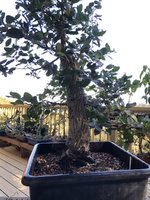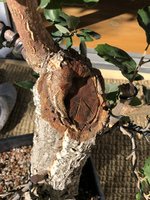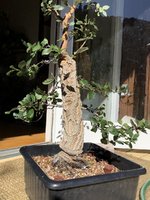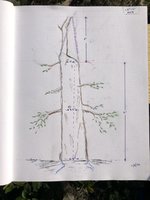TimberLakers
Mame
Picked up this Cork Bark Oak about a week ago - figured why not share some baseline pics.
Picture below is after some initial trimming and lower-branch wiring to get a better feel for the trunk line.

The tree is in great condition, soil is a mix of substrate/organic and drains well. Will make a decision on a Spring soil change or repot sometime in the winter, but will almost certainly leave it in a deep growing container. I'll be aiming for maximum growth over the next 4-5 years mainly to close up a chop.
I'm not sure when it was chopped, but it's rolling over nicely and the wood underneath was hardened and with evident rot. Leader is positioned nicely from the front of the tree. In the picture below, the right side branch will remain on the tree to help close the wound for the time being.

Below picture is after trimming and wiring the rest of the tree. The two upper-left most branches on chop junction are remaining for now to fatten the upper trunk, but I also quite like the lower one after raising it by ~1".
Left the branches long to encourage some branch thickening next season, and focused on creating movement near the trunk. Right smack in the middle of the tree is a wound from a removed branch. Maybe this heals over nice, maybe it becomes an interesting feature down the line.

There is more to the tree above that - unimportant to long-term design, and will largely grow free to fatten up the top.
Lowest left branch should be lower, but prefer to solve with a cutback in a season or two and have wired a branch as its eventual successor.
The soil and subsequent root line is still up in the air - something I'll think more about should I decide to change the soil mix this Spring. Hard to make a call on soil line without seeing what's under the hood.
I sketched out a scale design for the tree to get a better sense of how it should/could be down the road. From the normal bark line at the bottom of the tree, ignoring/burying exposed roots, the trunk is ~16" to the chop and tapers by ~1". In the drawing, I'm aiming for another 8" of trunk from the top of the chop. In the picture above, that's roughly the top of the picture.
Purple tip is a good idea about where I'd like the trunk to end up, about 3 chops and 12 years from now.
Redline would be a nice place for a bud to come through over the next few seasons. If not, I have some options to fill that space from the growth on the right side of the chop wound.

Picture below is after some initial trimming and lower-branch wiring to get a better feel for the trunk line.

The tree is in great condition, soil is a mix of substrate/organic and drains well. Will make a decision on a Spring soil change or repot sometime in the winter, but will almost certainly leave it in a deep growing container. I'll be aiming for maximum growth over the next 4-5 years mainly to close up a chop.
I'm not sure when it was chopped, but it's rolling over nicely and the wood underneath was hardened and with evident rot. Leader is positioned nicely from the front of the tree. In the picture below, the right side branch will remain on the tree to help close the wound for the time being.

Below picture is after trimming and wiring the rest of the tree. The two upper-left most branches on chop junction are remaining for now to fatten the upper trunk, but I also quite like the lower one after raising it by ~1".
Left the branches long to encourage some branch thickening next season, and focused on creating movement near the trunk. Right smack in the middle of the tree is a wound from a removed branch. Maybe this heals over nice, maybe it becomes an interesting feature down the line.

There is more to the tree above that - unimportant to long-term design, and will largely grow free to fatten up the top.
Lowest left branch should be lower, but prefer to solve with a cutback in a season or two and have wired a branch as its eventual successor.
The soil and subsequent root line is still up in the air - something I'll think more about should I decide to change the soil mix this Spring. Hard to make a call on soil line without seeing what's under the hood.
I sketched out a scale design for the tree to get a better sense of how it should/could be down the road. From the normal bark line at the bottom of the tree, ignoring/burying exposed roots, the trunk is ~16" to the chop and tapers by ~1". In the drawing, I'm aiming for another 8" of trunk from the top of the chop. In the picture above, that's roughly the top of the picture.
Purple tip is a good idea about where I'd like the trunk to end up, about 3 chops and 12 years from now.
Redline would be a nice place for a bud to come through over the next few seasons. If not, I have some options to fill that space from the growth on the right side of the chop wound.









